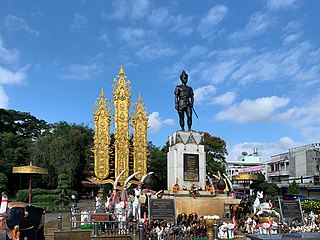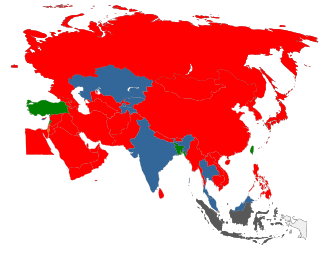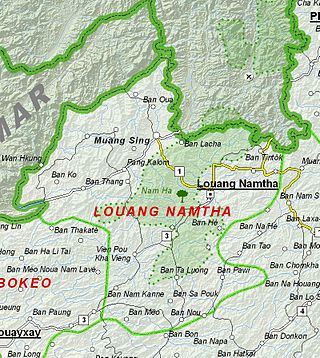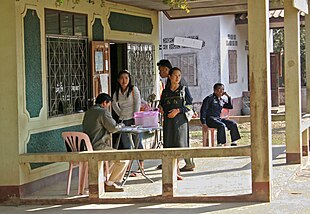
Chiang Rai is one of Thailand's seventy-six provinces, which lies in upper northern Thailand and is Thailand's northernmost province. It is bordered by the Shan State of Myanmar to the north, Bokeo province of Laos to the east, Phayao to the south, Lampang to the southwest, and Chiang Mai to the west. The provinces is linked to Houayxay Laos by the Fourth Thai–Lao Friendship Bridge that spans the Mekong.

Wa State is an autonomous self-governing polity in Myanmar (Burma). It is de facto independent from the rest of the country and has its own political system, administrative divisions and army. While the Wa State government recognises Myanmar's sovereignty over all of its territory, this does not include allegiance to any specific government. The 2008 Constitution of Myanmar officially recognises the northern part of Wa State as the Wa Self-Administered Division of Shan State. As a one-party socialist state ruled by the United Wa State Party (UWSP), which split from the Communist Party of Burma (CPB) in 1989, Wa State is divided into three counties, two special districts, and one economic development zone. The administrative capital is Pangkham, formerly known as Pangsang. The name Wa is derived from the Wa ethnic group, who speak an Austroasiatic language.

The Golden Triangle is a large, mountainous region of approximately 200,000 km2 (77,000 sq mi) in northeastern Myanmar, northwestern Thailand and northern Laos, centered on the confluence of the Ruak and Mekong rivers. The name "Golden Triangle" was coined by Marshall Green, a U.S. State Department official, in 1971 in a press conference on the opium trade. Today, the Thai side of the river confluence, Sop Ruak, has become a tourist attraction, with an Opium Museum, a Hall of Opium, and a Golden Triangle Park, and no opium cultivation.

Chiang Saen is a district (amphoe) in the northern part of Chiang Rai province, northern Thailand. Chiang Saen is an important entrepôt for Thailand's trade with other countries on the upper part of Mekong River.

The Chin Haw or Chin Ho, also known locally as Yunnanese, are Chinese people who migrated to Thailand via Myanmar or Laos. Most of them were originally from Yunnan, a southern province of China. They speak Southwestern Mandarin.

Pheung Kya-shin was the chairman of the Shan State Special Region No. 1 in Myanmar (Burma) and the leader of the Myanmar National Democratic Alliance Army (MNDAA) from 1989 to 2009.
Mong La Township is a subdivision of Kengtung District, Shan State, Myanmar. The area borders China and Laos. The principal town is Mong La.

Mong La or Mongla, also known as Little Mong La to distinguish it from neighbouring Mengla County in China, is the administrative seat of Mong La Township in Shan State, Myanmar.

Prostitution in Laos is regarded as a criminal activity and can be subject to severe prosecution. It is much less common than in neighbouring Thailand. Soliciting for prostitution takes place mainly in the city's bars and clubs, although street prostitution also takes place. The visibility of prostitution in Laos belies the practice's illegality. As of 2016, UNAIDS estimates there to be 13,400 prostitutes in the country.

The Mekong River massacre occurred on the morning of 5 October 2011, when two Chinese cargo ships were attacked on a stretch of the Mekong River in the Golden Triangle region on the borders of Myanmar (Burma) and Thailand. All 13 crew members on both ships were killed and dumped in the river. It was the deadliest attack on Chinese nationals abroad in modern times. In response, China temporarily suspended shipping on the Mekong, and reached an agreement with Myanmar, Thailand and Laos to jointly patrol the river. The event was also the impetus for the Naypyidaw Declaration and other anti-drug cooperation efforts in the region. On 28 October 2011, Thai authorities arrested nine Pha Muang Task Force soldiers, who subsequently "disappeared from the justice system". Drug lord Naw Kham and three subordinates were eventually tried and executed by the Chinese government for their roles in the massacre.

Bokèo is a northern province of Laos. It is the smallest and least populous province in the country. Bokeo province covers an area of 6,196 square kilometres (2,392 sq mi). Bokeo province borders Luang Namtha province to the northeast, Oudomxai province to the east, Xaignabouli province to the south, and Thailand to the southwest and Burma to the west and northwest. The province has five districts: and The provinnce has Golden Triangle Special Economic Zone in Ton Pheung district. It is rich in deposits of precious and semiprecious stones. Bokeo's provincial capital is Houayxay on the Mekong River. The province is in the Golden Triangle, at the border of Myanmar and Thailand. There are 34 ethnic groups in the province. Houay Xay is the border town with Thailand and regional economic centre.

Luang Namtha is a province of Laos in the country's north. From 1966 to 1976 it formed, together with Bokeo, the province of Houakhong. Luang Namtha province covers an area of 9,325 square kilometres (3,600 sq mi). Its provincial capital is Luang Namtha. The province borders Yunnan, China to the north, Oudomxai province to the east and southeast, Bokeo province to the southwest, and Shan State, Myanmar to the northwest.

Opium production in Myanmar has historically been a major contributor to the country's gross domestic product (GDP). Myanmar is the world's largest producer of opium, producing some 25% of the world's opium, and forms part of the Golden Triangle. The opium industry was a monopoly during colonial times and has since been illegally tolerated, encouraged and informally taxed by corrupt officials in the Tatmadaw, Myanmar Police Force and rebel fighters, primarily as the basis for heroin manufacture. While opium poppy cultivation in Myanmar had declined year-on-year since 2015, cultivation area increased by 33% totalling 40,100 hectares alongside an 88% increase in yield potential to 790 metric tonnes in 2022 according to latest data from the United Nations Office on Drugs and Crime (UNODC) Myanmar Opium Survey 2022 With that said, the United Nations Office on Drugs and Crime (UNODC) has also warned that opium production in Myanmar may rise again if the economic crunch brought on by COVID-19 and the country's February 1 military coup persists, with significant public health and security consequences for much of Asia.
Crime is present in various forms in Myanmar and is continuous with the activities of many drug trafficking financed militias at the eastern and western border regions, and with corruption within and challenges to the central government.
The Kuomintang in Burma or Kuomintang in the Golden Triangle were Kuomintang troops that fled from China to Burma in 1950 after their defeat by the Chinese communists in the Chinese Civil War. They were commanded by General Li Mi. It attempted several incursions into Yunnan in the early 1950s, only to be pushed back into Burma each time by the Chinese Communist Party's People's Liberation Army.

The Golden Triangle Special Economic Zone is located along the Mekong River in the Ton Pheung District of Bokeo Province in Laos. The zone has an area about 3,000 hectares and was created in 2007 by the Lao government together with the Chinese-owned Hong Kong-registered company Kings Romans Group with the hope of generating economic development.
Shwe Kokko Myaing, commonly known as Shwe Kokko, is a town in Myawaddy Township, Myawaddy District in the Kayin State of south-east Myanmar. Shwe Kokko lies on the left (western) bank of the Moei River, facing Thailand to the east. The town is located 20 kilometres (12 mi) north of Myawaddy. In recent years, Shwe Kokko has evolved into an organized crime and human trafficking hub, due to the Burmese government's limited reach and oversight in this remote area. Chinese-led development projects in Shwe Kokko, including Yatai New City, have been involved in illegal gambling, human trafficking, extortion, and cyber scam operations. As Cambodia intensified its crackdown on illegal online gambling in 2019, Chinese crime syndicates and casino operators have found a new base in Myanmar's peripheral border areas.

Ban Sop Ruak is a village in Wiang subdistrict (tambon) of Chiang Saen District (amphoe) in Chiang Rai Province, northern Thailand. The village is situated at the confluence of the Ruak River and the Mekong River which form the tripoint border of Thailand, Myanmar, and Laos. This location has enabled it to be marketed to tourists as the "heart" of the Golden Triangle, as the area is popularly known.
Zhao Wei is a Chinese businessman and the founder of Hong Kong registered company Kings Romans Group, which owns the Kings Romans casino franchise. The United States Treasury Department imposed sanctions on what they designated the Zhao Wei Transnational Criminal Organization in 2018 for its alleged involvement in laundering money and assisting in the storage and distribution of heroin, methamphetamine, and other narcotics for illicit networks, including the United Wa State Army which operates in Myanmar. Based in Laos in the Golden Triangle Special Economic Zone (GTSEZ), Zhao Wei is also reported to engage in human trafficking, bribery, wildlife trafficking, and other forms of transnational organized crime. Much of this illicit activity is allegedly conducted through the Kings Romans casino organisation in the GTSEZ.
A fraud factory or fraud park is a collection of large fraud organizations usually involved in human trafficking operations, commonly found in Southeast Asia and usually operated by a criminal gang. Fraud factory operators lure foreign nationals to scam hubs, where they are forced into modern slavery, to scam internet users around the world into fraudulently buying cryptocurrencies or withdrawing cash, via social media and online dating apps. Trafficking victims' passports are confiscated, and they are threatened with organ harvesting and forced prostitution if they do not scam sufficiently successfully.














